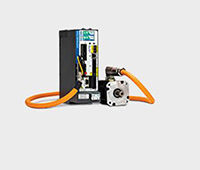
Top: A Hi-Speed Snap-In Tire Pressure Monitoring Sensor (TPMS) used to monitor tire pressure and send measurement info. Bottom: 10x amplification of stress and deformation on the transmitter housing as a result of centrifugal loading produced by the wheel’s rotation.
Miniature sensors that regulate automobile performance are designed in a very particular way to operate properly while housed directly on moving automobile tires. They need to have the sensitivity to pick up measurements while in motion and the durability to withstand the elements.
Tire pressure is the unsung hero of automobile performance. When inflated to the proper pressure, tires are the exact shape that the designers intended. As air pressure decreases, the tires need more energy to move. Drivers can easily forget to maintain their tire pressure in the day-to-day routine of moving from one place to another. Punctures can take place and go completely unnoticed.
That is why having an onboard sensor that alerts the driver when it’s time to add more air makes all the difference. Creating these sensors requires careful consideration of all the fine details, and simulation provides the tools for finding just the right design.

A spin test simulated on the collar of the device shows stress induced by the centrifugal force concentrated at the bolt locations.
Tire pressure sensors shape driving experience
One consequence of low tire pressure is a significant reduction in fuel economy. Additionally, vehicles running on low tires can add tons of greenhouse gases to the atmosphere over time. Low tire pressure can also make it hard for the vehicle to stop, or cause the car to slip on wet surfaces. Automakers are generally required to attach pressure-monitoring sensors to wheels that inform drivers if a tire falls below the intended pressure. Schrader Electronics is currently the global market leader in tire-pressure monitoring technology.
Schrader Electronics manufactures 45 million sensors annually and provides sensors to leading automotive companies including GM, Ford and Mercedes. For a sensor to survive road conditions throughout the life of a vehicle, reliability and durability are key. Consideration is given to shock, vibration, pressure, humidity, temperature and various dynamic forces when designing for the necessary functions, geometry and materials. Christabel Evans, an engineer with the Schrader Electronics mechanical design team, has been using finite element analysis (FEA) and multiphysics simulation to build successful, efficient tire sensors for all kinds of vehicles.
Designing better sensors with FEA
The Hi-Speed Snap-In Tire Pressure Monitoring Sensor is a frequently used product at Schrader that mounts directly on the wheel assembly and measures tire pressure—even when the car is in motion. When the tire pressure decreases too much, a warning goes off, alerting the driver that it is time to stop and re-inflate the tire.
Schrader Electronics has been creating sensors for almost 20 years, but Evans and her colleagues wanted a more efficient approach for product design and testing. They simulated their designs using FEA and iterated the process, which allowed them to minimize experimental cost and evaluate design performance during development.
Schrader Electronics found that the existing FEA software options were expensive if they wanted to deploy it to their entire team. They turned to using the Structural Mechanics Module and the CAD Import Module of COMSOL Multiphysics. They started with a series of tests, comparing standardized samples with simulations to validate the software and build confidence in the results.

COMSOL is used by many engineers across multiple teams within the Mechanical Engineering Department at Schrader Electronics. From left to right: Andrew Herron, Sam Guist, Adam Wright, Christabel Evans, and Russell McKee.
Improving sensitivity and durability with better simulation tools
Over time, the researchers began incorporating more natural parameters into their simulations, from dynamic loads, such as centrifugal force, to environmental stresses, such as temperature change, and static factors, such as pressure and crush load. The Hi-Speed Snap-In TPMS consists of a transmitter made up of a circuit housed in an enclosure and attached to a valve stem with a cap. The valve stem connects to the tire rim and allows air to pass through. On the Hi-Speed TPMS, the valve geometry includes a rib that helps retain the assembly in the rim hole.
Schrader Electronics measured the stress on the enclosure from outside forces like tire fitment, shock or vibration from the road conditions, and the deformation that occurs when the device is loaded under these conditions. The resulting simulation shows a component designed for a spin test machine that rotates the part at high speed. This component was analyzed to verify that the material choice would be able to handle the required loads.
By analyzing several models simultaneously, Evans and her team were able to find the one that works best and improve upon their design. They focused on testing different geometries, materials and load scenarios.
The researchers at Schrader were able to learn COMSOL Multiphysics software much faster than similar simulation packages, and deployment through the organization was easier because of flexible licensing options. According to Evans, “COMSOL is user-friendly and it is fast to learn—the engineers picked it up right away.”
At the moment, the engineers at Schrader plan to spend most of their focus on design and growth, with some emphasis on failure analysis, but they hope to improve their development-focused approach with the aid of simulation tools. They are working hard to improve driver comfort, environmental impact and road safety with each new design.
COMSOL
comsol.com
Filed Under: Software • 3D CAD, Sensors (pressure), ENGINEERING SOFTWARE, MOTION CONTROL, SENSORS





Tell Us What You Think!